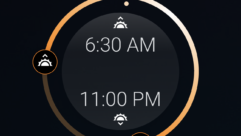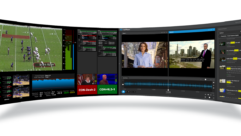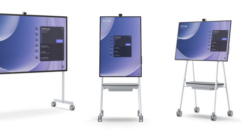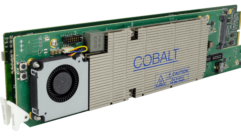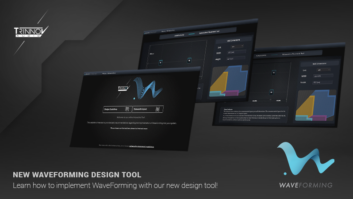Road to InfoComm Podcast with Jason McGraw
In this edition of the Special Road to InfoComm Podcast, SVC Contributing Editor Bennett Liles talks with Jason McGraw, Senior Vice President of Expositions for InfoComm International. Jason provides the logistical details of setting up the InfoComm show including load-in, coordinating trucks, power arrangements and even the precautions for the drone demonstrations.
Links of interest:
- InfoComm 2017 Show
- Orange County Convention Center
- Top Tips from the InfoComm 2017 Management Team
- The InfoComm Experience
Download Podcast Here:
https://s3.amazonaws.com/nb-svc/public/public/Road_to_InfoComm_3_Jason_M…
Transcript-
From Sound & Video Contractor Magazine, this is the Road to InfoComm Podcast with Jason McGraw. Show notes for the podcast are on the web site of Sound & Video Contractor Magazine at svconline.com.
Can you imagine what it takes to get the InfoComm show all set up and being the go-to guy for making sure all it gets done on time? Jason McGraw, Senior Vice President of Expositions for InfoComm International is with us today. He’s going to tell us how they load in, set up, get power to everybody and accommodate the drone demonstrations. That’s next up on the Road to InfoComm Podcast.
Jason, thanks for taking time out of an incredibly busy schedule right now to get with us on the Sound & Video Contractor Road to InfoComm podcast. Senior Vice President for Expositions with InfoComm International. You’ve got to be one of the busiest guys around this week.
[Laughs] Absolutely, Bennett. We work all year long – actually almost two years in advance – to plan the show. So getting down here to the final days before the show opens is quite exciting. [Timestamp: 1:15]
Well, it’s great of you to carve out a few minutes to give us some insight to what happens backstage and how all of this is rolled in and set up. Once our listeners are out on the floor this time they’ll have a good idea of how it all comes together.
Absolutely.
This year there are a lot of new things going on. Is there anything in the way of significant new challenges in setting up this year’s show?
Well, each year we kind of start from scratch. You know, we work with the exhibitors to book their exhibits on the show floor. In fact, we’ve already started to do that for next year’s show in Las Vegas already with our top 150 exhibitors. We actually book their spaces before the opening of this year’s show. But we continue that on during the show week for the next year and book 80-plus percent of our space at the current show for the following year’s show from our major exhibitors. Then we spend the rest of the year working on trying to get all the other companies signed up. And each year we have a couple hundred new exhibitors that join us. So even though we go back and forth between Orlando and Las Vegas it is really starting from scratch with a fresh plan every year. Also taking a complete, fresh look at our content programs offered at the show over the course of the show week. We look at the special features and special events and how do we keep the show fresh and interesting? And of course, playing host to some of the greatest technology solutions that are out there in the pro A/V space from all the leading brands. So it’s a really exciting endeavor to be involved from the staff perspective in helping to organize the event and we hope everybody comes and has a great time. [Timestamp: 2:52]
Well, the technology is changing so fast that we probably don’t have a complete idea of what it’s going to look like just a couple of years down the road. There is one fairly new technology area and it’s of real interest to me and that’s the drones. They have drone manufacturers at the show and that’s a tricky thing to demo inside a building so do you have to make any sort of special arrangements for those?
Mm-hm. Well, you know in the past we had a drone pavilion with a large cage – you know, a drone cage netting that we had set up so that those could be demoed on the floor. We have a couple of exhibitors this year that have those in their booths and, you know, showing off the drones. You know, we’ve partnered with Stampede, one of our member/distributors, who carries a full line of drone manufacturers’ products as well and think they’re going to have some demos in their booth this year on the show floor. But yeah, you can’t let them free fly around the exhibit hall. There’s just so much wiring and rigging and signs and so forth it poses a flight risk, so having an enclosed cage area for demo is usually the way to go. [Timestamp: 3:56]
That’s got to be a unique thing these days having to accommodate flying objects inside of a building? … You have some very special things going on and of course all of these products and exhibits have to run on power. Just getting power to everybody and seeing that nobody trips breakers but making sure that all the exhibits get the juice they need. Who does that? Is that the Orange County Convention Center people or InfoComm or do you all work side by side on it?
Absolutely. We contract with the Orange County Convention Center. Their in-house services handle all the electrical and rigging in the Orange County Convention Center. It’s different in Las Vegas. Our friends with Freeman Companies, they do the rigging and electrical there. But in the building in Orlando, they have very qualified electricians and riggers that handle all that. With the amount of hardware on our show and LED screens and projectors and flown signs and lighting, it’s a very significant amount of electrical and rigging. Fortunately the building has got fantastic infrastructure so frankly we’ve not really had any problems in the past with brownouts or power flickering off and on, that type of thing. They do a really great job with that, but it’s a lot of planning in advance, especially from our perspective as show management. Also the individual exhibitors having their electrical plans and lighting plans and rigging plans and getting that all submitted in advance and they just go to town and have crews up there and lifts up in the catwalks. It takes almost a full seven days – six, seven days – to get the show moved in and set up and ready for Wednesday morning. [Timestamp: 5:37]
Well, the power is basic to this but also basic is just getting everybody in and out. There is so much stuff to load in and set up and then get out of there. How do you schedule the passage of all of that gear in and out of the building so that you don’t end up with a bottleneck somewhere and things piling up and waiting.
Well, our general services contactor, Freeman, they do a fantastic job. They’ve got a large marshalling yard close by the convention center and a large warehouse and cross dock. A lot of the exhibitors ship some of their freight in advance to Freeman’s warehouse and then it’s brought over. Trailers, there’s a lot of exhibitors that ship directly to the show. In fact, Freeman loads over 700 tractor-trailer-fulls of freight. It’s many, many millions of pounds of equipment that come in. The West Building of the Orange County Convention Center has over 100 docks on the backside of the building so they’re able to strategically unload and queue up the trucks. And then we have what’s called a target plan. So not all the exhibitors can come in on the same day at the same time. They strategically go through and as you can imagine the larger booths that are up in the front of the hall they try to load from the front of the hall and work their way back. So not everybody comes in all at one time, but they work hard every day to get everything unloaded. And then they’ve got to remove all the empty crates and store them during the show and then return them at the end of the show. So it’s quite an endeavor. There’s over 1,300 laborers that work; Teamsters and stagehands and decorators and carpenters and all kinds of folks that are working on the show to get it set up in edition to the exhibitor personnel there. So it’s quite amazing to go from bare concrete floor to the fantastic exhibits that we see when the show opens. [Timestamp: 7:25]
Yeah, I’d love to see a time lapse of the empty building and then everything going in. I’m sure somebody has done that. I know that there are so many potential mines to step on in this job but there have to be positive aspects to it so what’s your favorite part of the whole thing?
[Laughs] I get asked that question almost every year. I can tell you personally, and I’ve been doing tradeshows for 30 years, my favorite – absolute favorite time besides the ribbon cutting, right? So you work very hard to make sure the show opens on time and everything is done. So that’s a significant milestone. But actually midnight before the show opens I’m going around the show floor and just checking everything out. It’s kind of like if you can imagine yourself going through the shopping mall and the stores at night when there’s nobody there before the stores open and everything is pristine, everything is all done, the carpet is down and the exhibits look magnificent. You know, it’s just a real sense of pride in our team and the exhibitors and just have that moment of peace before the chaos of the show floor opening and everybody streaming in and having a great time. That’s probably my favorite time. You know, and it’s bittersweet when the show closes. So much work and so many hours and months and years went into planning this one three-day event and then it’s over with. And everybody strikes their exhibits and they’re out of there in just a couple of days. So it goes up, looks great, and then it comes down and then you work on it again. So it’s a lot of fun. It’s exhilarating and bittersweet and exciting, but more than anything it’s a sense of pride that I think – and I’m speaking for our staff – that we have the honor and privilege of serving the industry and playing host to such a great collection of brands and visitors. We have over 40,000 visitors this year from all 50 U.S. states and over 100 countries around the world. So it’s really a great gathering. [Timestamp: 9:14]
Well, now we know where you’re going to be at midnight before the show but while we’re all out there enjoying the show on the exhibit floor, are you going to be doing that or where are you going to be?
You know, I end up having so many different meetings and I do try to take an hour or two each day to get out there myself and see and meet with a bunch of our exhibitors. And then I certainly have some different honorary duties to pick winners for different contests and photo ops and handshakes and so forth. But no, it’s really great and I’m lucky if I spend the last couple of hours on Friday afternoon before it closes just really getting to soak it all in because it’s quite a busy week. [Timestamp: 9:55]
One thing that I think is all new is the TIDE Conference. Technology, innovation, design and experience.
Absolutely. This is a totally new concept for us. So much of our show focuses on the technology itself and the application of the technology. This year we really tried to put a conference together that focused on how do you create better experiences with the technology and focus on solutions and outcomes for the customers? In particular it’s about storytelling. How do you leverage technology to create those experiences and tell stories? And so it’s really about looking at creativity and using different technologies that are new and emerging, like say virtual reality, for example. So we put together an all-star, stellar cast of subject matter experts to speak at this one-day conference. It’s the day before the show opens on Tuesday. And then we have some custom tours for those attendees that they can go around and see some of the solutions on the show floor and kind of connect the dots between a lot of the thought-provoking ideas they got in the TIDE conference and then seeing what’s on the show floor. And that’s complimented by a new area that we have called Center Stage that’s also a thought leadership area of 20-minute sessions that go on throughout the three days on the show. It’s Booth 3461. It’s right in the back of Hall B. And we’re going to also have another collection of 25 different subject matter experts giving demos and kind of TEDx-style talks on the same kind of thing. How do you leverage technology to create better solutions and outcomes and experiences for customers? So we think that’s a really great add this year having the TIDE program, the Center Stage program on the floor and those really compliment the huge program that we have Tuesday through Friday. In our seminar workshop package we have over 170 sessions, workshops and manufacturer training session that kind of cover the whole spectrum of technologies and applications and solutions and everything from networked A/V to unified communications and collaboration. Talking about technologies that work security and then everything from audio, lighting, live events, digital signage, display technology, control systems – we’ve got it all covered. It’s really a fantastic program and it wouldn’t be possible without all the volunteers that we have in the industry that step forward and share their knowledge. So we have over 150 speakers this year at the program as well, the biggest program we’ve ever had. [Timestamp: 12:29]
It’s going to be incredible this year and we have new things to see along with all of the good stuff that we’re already used to and I very much appreciate your taking time out to tell us about what’s coming up. Jason McGraw, Senior Vice President for Expositions with InfoComm International. A very busy guy right now and thanks for getting with us.
Thanks, Bennett. We look forward to seeing everyone in Orlando. Take care.
Thank you for being here with us for the Road to InfoComm Podcast with Jason McGraw, Senior Vice President of Expositions for InfoComm International. It’s coming down to the wire on this year’s show so have a safe trip and a great time at InfoComm 2017.


